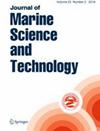A methodology for statistical mean wave climate regime characterisation in oceanic islands: the case of the southern coast of Tenerife
IF 2
4区 工程技术
Q2 ENGINEERING, CIVIL
引用次数: 0
Abstract
Oceanic islands of volcanic origin tend to have peculiar characteristics, such as: exposure to many wave directions; grouping in archipelagos; steep coastal slopes; and small coastal shelves. All these features require certain considerations in wave climate studies. These types of studies, when wave spectra are not available and have to be performed with parametric data, can be unreliable without an adequate systematic treatment. In this work we propose a methodology consisting of pre-classification according to the peak period and subsequent separation into different sectors according to the geographical fetch. The island of Tenerife is the case study, and in particular the waves reaching its southern coast. Data from the existing deep-water buoy have been used in this work. A range of fetch lengths between the few miles of distance to the neighbouring islands, and more than 5,500 nautical miles that separate it from the Antarctic region have been considered. The dominant type of waves and the direction of provenance in each season of the year have been characterised. The proposed methodology has been designed to be applied to any oceanic archipelago with similar characteristics to those mentioned above.海洋岛屿统计平均波浪气候状态特征的方法:以特内里费岛南部海岸为例
火山起源的大洋岛屿往往具有独特的特征,例如:暴露于许多波浪方向;成群岛的;陡峭的海岸斜坡;还有小型海岸大陆架。所有这些特征都需要在波浪气候研究中加以考虑。当波浪谱不可用时,这些类型的研究必须用参数数据进行,如果没有适当的系统处理,可能是不可靠的。在这项工作中,我们提出了一种方法,包括根据高峰时期的预分类和随后的分离到不同的部门根据地理获取。特内里费岛是一个研究案例,尤其是到达其南部海岸的海浪。在这项工作中使用了现有深水浮标的数据。从几英里到邻近岛屿的距离,到5500多海里与南极地区的距离,都在考虑范围之内。一年中每个季节的主要波浪类型和来源方向已被确定。拟议的方法已被设计用于任何具有类似上述特点的海洋群岛。
本文章由计算机程序翻译,如有差异,请以英文原文为准。
求助全文
约1分钟内获得全文
求助全文
来源期刊

Journal of Marine Science and Technology
工程技术-工程:海洋
CiteScore
5.60
自引率
3.80%
发文量
47
审稿时长
7.5 months
期刊介绍:
The Journal of Marine Science and Technology (JMST), presently indexed in EI and SCI Expanded, publishes original, high-quality, peer-reviewed research papers on marine studies including engineering, pure and applied science, and technology. The full text of the published papers is also made accessible at the JMST website to allow a rapid circulation.
 求助内容:
求助内容: 应助结果提醒方式:
应助结果提醒方式:


